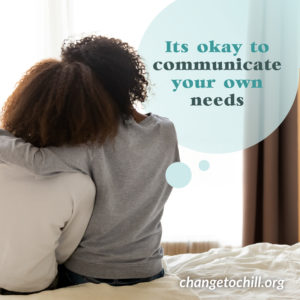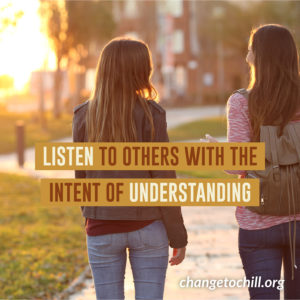Healthy Communication
Healthy communication is a skill we can learn and practice throughout our lives. Communication is part of all our relationships – with friends, teachers, family members, partners, ourselves, colleagues and strangers. It’s a skill that always can be improved.
How can you tell the difference between healthy and unhealthy communication? Here are some examples of both to help you improve your communication skills which can lead to finding solutions to conflicts.



Healthy Communication Styles
Assertive Communication
In assertive communication, you clearly state your thoughts, opinions and feelings without violating the rights of others. This communication style places value on the other person’s time, self, and spiritual, mental and physical needs.
- Verbal examples of assertive communication:
- “I feel frustrated and talked over when I am interrupted. I need space to communicate my thoughts and feelings.”
- “I feel hurt when I hear jokes about what I am wearing. I need respectful communication about my appearance.”
- Nonverbal examples of assertive communication:
- direct, non-threatening eye contact
- calm, clear tone of voice
- relaxed body posture
- express feelings clearly, appropriately and respectfully
Active Listening
Communication goes both ways. You and the other person or group have the right to feel and express your emotions. It is important to listen to hear, not to respond. When others talk, pay attention; avoid automatically dismissing or discounting their feelings. The other person is the expert about their own thoughts and feelings, just as you are with yours. Follow these steps to become a more active listener:
- Pay attention. Give the speaker your undivided attention and set aside distracting thoughts.
- Show that you are listening. Use non-verbal cues and body language such as occasional nods and eye contact to show that you’re listening.
- Provide feedback. Reflect on what the speaker said by paraphrasing and ask questions to clarify.
- Defer judgment. Allow the speaker to finish each thought before asking questions. Avoid interrupting or arguing..
- Respond appropriately. You are gaining information and perspective. Give your opinion while you treat the speaker with respect.
Unhealthy Communication Styles
Aggressive Communication
Aggressive communication are words, phrases and nonverbal cues that express your needs without taking into account the feelings of others. The words and phrases used can come across as insults and put you in conflict with another person or group. Aggressive communication comes across as if you are:
- looking down on someone
- making an assumption
- making a generalization
- placing blame
- being sarcastic.
- Verbal examples of aggressive communication:
- “You are ALWAYS late!”
- “How could you think that was a good idea?”
- Nonverbal examples of aggressive communication:
- pointing or clenching fists
- violating someone’s personal boundaries
- smirking
- wide, constant eye contact
Passive
Passive communication happens when you do not express your opinions or true feelings. People with this communication style try to avoid conflict. Your feelings can then build up without other person ever knowing or understanding how you feel. These unexpressed feelings can build until a triggering event or comment can lead to an explosive outburst. The result? Feelings of resentment, shame, guilt and even more passive communication.
- Verbal examples of passive communication:
- “I’m okay with whatever you want to eat.”
- “You’re right, that was a silly idea,”
- Nonverbal examples of passive communication:
- avoiding eye contact
- slumped posture
- looking down
- allowing others to infringe on rights.
Passive-aggressive
Passive-aggressive communication can happen when you act out anger in subtle, indirect ways. When you do not clearly state what you’re thinking or feeling it can leave people feeling confused, hurt or upset. A passive-aggressive communication style can lead other to feel resentful and your comments may be seen as undermining, blaming and withholding how you really feel.
- Verbal examples of passive-aggressive communication:
- “It would be nice if someone cared about my game today.”
- “No, I don’t care, I’ll just do it by myself.”
- Nonverbal examples of passive-aggressive communication:
- silent treatment
- spreading rumors
- sabotage
- leaving notes to avoid direct communication
Bullying
Bullying can happen anywhere at any time to anyone. Bullying hurts everyone: the bully, the person being bullied and bystanders (people who witness someone being bullied). When you know what bullying is, it’s easier to stop it. Learn more about bullying it and how to stop it.
How to Have Healthy Communication
How to Have Healthy Communication
To communicate in a healthy way, it is important to:
- Say what you want and how you feel in a respectful way.
- When dealing with conflict, address the issue directly and as soon as possible.
- Focus on your own thoughts, feelings and experiences. This helps you express how you’re feeling instead of putting the focus on the behavior of others over which you have no control.
- Try using “I” statements and avoid using the word “you”. A general formula to follow is “I feel ______________ when ____________. I need ____________.” This allows you to express how you are feeling and what you need. How the other person responds is out of your control.
Setting Boundaries
Boundaries are an important part of healthy communication. Limits and boundaries are about respect for yourself and for others. If you have a hard time saying “no,” often set aside your own needs to please others, or are bothered by someone else’s actions toward you, you have the right and the responsibility to speak up. You can set respectful boundaries in your life around your time, space, privacy, property, spirituality, feelings and conflict. Boundaries are learned over time and take practice to set and maintain. Use our “Setting and Maintaining Boundaries” handout to get started.
Resolving Conflict
Conflict in relationships is normal. Conflicts arise anywhere people gather, in the classroom, at home, at work, and other activities. Conflict can be healthy if it encourages a shared understanding which leads to positive change. Unhealthy conflict however, can be an obstacle to any group who is trying to reach a goal. Unresolved conflict can damage your self-esteem or hinder your group or team’s ability to work together. Learning to resolve conflict in a healthy way is important. It is critical to:
- Separate the issue or the problem from the people involved.
- Respect and value all opinions (which does not mean you have to agree).
- Be willing to have a respectful discussion that explores different sides of an issue and that seeks a resolution.
Steps to Take to Resolve Conflict
Remember, conflict is often about the issue, not the person. Engaging in healthy conflict can help expand your views and increase your understanding of others.
- Stop, think and evaluate your purpose.
-
- Think about and plan how to discuss an issue.
- Plan what you want to say to limit further misunderstanding.
- Evaluate the purpose of the conflict or discussion. This can help clarify your goals and identify when it is time to step away or engage further.
- It is not a productive discussion if your only hope is to change the other person’s opinion or “win” an argument.
- Listen and respectfully communicate your needs.
-
- Listen to hear, not to respond.
- Use active listening skills to try to understand other points of view. People who feel their opinions have been heard are more likely to work toward a solution.
- Try using “I feel” statements to share your feelings without placing blame.
- Use the “Healthy Communication Prompts” handout for ideas on how to start a conversation or how to communicate effectively.
- Be aware of your own defense mechanisms and assumptions.
-
- Few conflicts have an absolute right or wrong answer. Understanding all sides of a conflict may start a conversation instead of further increasing the conflict.
- Be aware of your own defenses and assumptions.
- Share your frame of reference and assumptions with others and ask them to do the same.
- Seek common ground and ask clarifying questions.
-
- Find areas where both sides agree. Try not to focus only on areas of disagreement.
- Seek common ground to bring down defenses and increase the chances of a shared solution. Clarify and define the real issue which may be buried under misunderstanding and emotion.

 Pinterest
Pinterest  Instagram
Instagram 

